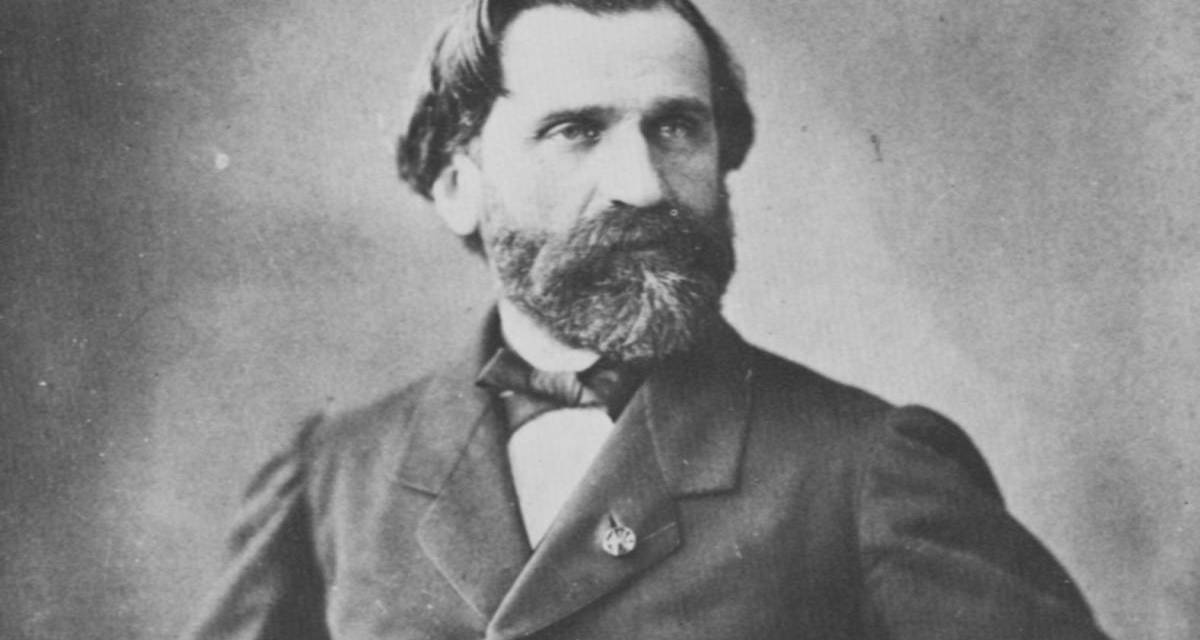Name: Giuseppe Fortunino Francesco Verdi
Born: 9 or 10 October 1813
Died: 27 January 1901
Place of birth: Le Roncole, Parma, Italy
Known for: one of the pre-eminent opera composers in history, he came to dominate Italian opera and remains incredibly popular today
Career
Along with Wagner, Verdi was one of the greatest 19th century composers. He had a long and distinguished career, writing an astonishing 28 operas among many other works; 16 of these were composed in an 16-year period from 1840, what Verdi referred to as his ‘galley-slave’ years; “Since Nabucco, you may say, I have never had one hour of peace. Sixteen years in the galleys.”
The composer staged his first opera in 1839. Oberto was first performed at the Teatro alla Scala, Milan, on 17 November 1839. It was a relative success, with a further 13 performances, and impresario Bartolomeo Merelli commissioned three more works. His next effort, Un giorno di regno (King for a Day, 1840), was an abject failure and Verdi vowed to give up composing forever. Fortunately he was persuaded to change his mind.
Verdi’s third opera Nabucco, which premiered at La Scala in March 1842, catapulted him to national fame. It is still performed today, while its celebrated chorus of the Hebrew slaves, ‘Va pensiero’, remains a firm staple of Italian culture.
From then on Verdi was virtually unstoppable, producing some of opera’s best-known and most impressive works, including La traviata (The Fallen Woman), Rigoletto (1851) and Il trovatore (The Troubadour, 1853). The first, based on Alexandre Dumas’s play The Lady of the Camellias, was poorly received when it premiered in March 1853. Verdi commented: “La traviata last night a failure. Was the fault mine or the singers’? Time will tell.” A year later, with minor revisions, it was warmly received and become immensely popular – today it is the most frequently performed of all operas.
Verdi firmly established himself as the greatest Italian opera composer of the Romantic era. He composed an astonishing number of operas that remain popular today: Simon Boccanegra (1857), Un ballo in maschera (A Masked Ball, 1859), La forza del destino (The Power of Destiny, 1862), Don Carlos (1865) and Aida (1872) are just a few.
After Aida, Verdi considered himself retired from the operatic scene, although he did continue to write other music, including his ever-popular Requiem, a tribute to Rossini. Verdi was persuaded out of his semi-retirement to compose two further operas: Otello (1886) and his last dramatic work Falstaff (1893). The latter was a stunning success, premiering when its composer was 80.
Personal life
Giuseppe Verdi was born in October 1813 to Carlo Giuseppe Verdi and Luigia Uttini. A sister, Giuseppa, was born three years later; she died at 17 in 1833. The family was of moderate means, rather than the illiterate peasants that Verdi liked to later claim.
The boy was well educated, with a solid grounding in Latin, Italian, the humanities and rhetoric, as well as music. He showed early promise as a musician and composer, standing in for his teacher as an organist as young as nine and writing music for the local church choir, of which he was a member.
In 1836, Verdi married Margherita Barezzi, daughter of Antonio Barezzi, a merchant and Verdi’s patron. The couple had two children, Virginia Maria Luigia on 26 March 1837 and Icilio Romano on 11 July 1838. Both children died before reaching their second birthdays. Margherita followed in 1840; she was just 26. Verdi was devastated, and yet he managed to compose Nabucco in 1940, after which followed period of great productivity.
In 1947 Verdi embarked on a romantic relationship with the opera singer Giuseppina Strepponi. She was a controversial figure, known for her amorous relationships and several illegitimate children. The unmarried couple lived together in Busseto, their status causing much scandal. They married in 1859 and remained together until her death in 1897.
Though generally happy, their marriage wasn’t without its problems. In the 1870s Verdi was accused of having an affair with the soprano Teresa Stolz, the wife of conductor Angelo Mariani, with whom Verdi had a major falling out after the latter didn’t show what Verdi considered to be sufficient enthusiasm for the composer’s Requiem. Though there is no evidence of an affair, Strepponi’s personal papers reveal a great deal of distress.
The musical genius was also quite the businessman. After his planned retirement in 1873, Verdi settled in Sant’Agata, where he became a major landowner and very wealthy man. He also funded major charitable works including a hospital for agricultural workers and the Casa di Riposo per Musicisti, a home for old and penniless musicians that is still in operation in Milan.
Verdi suffered a stroke on 21 January 1901 and died six days later. He left behind a stunning body of work that remains at the heart of opera repertory. Indeed, the 1910 edition of Grove’s Dictionary of Music and Musicians – more simply known as Grove’s Dictionary – described him as “one of the greatest and most popular opera composers of the 19th century”.
Did you know?
Verdi probably wasn’t the easiest of men to get along with. John Rosselli, who wrote a Life of the composer, concluded that: “I do not very much like the man Verdi, in particular the autocratic rentier-cum-estate owner, part-time composer and seemingly full-time grumbler and reactionary critic of the later years.”
Best-known works
Too many to list them all, but these include Nabucco, Rigaletto, Il trovatore, La traviata, Otello and Falstaff.
Image
Giuseppe Verdi (1813-1901) (Zeno Fotografie; commons.wikimedia.org).


Verdi composed the Requiem not for Rossini but his good friend and fellow senator of the kingdom of Italy. : Alessandro Manzoni the author of the Promessi Sposi a classic of Italian Literature.